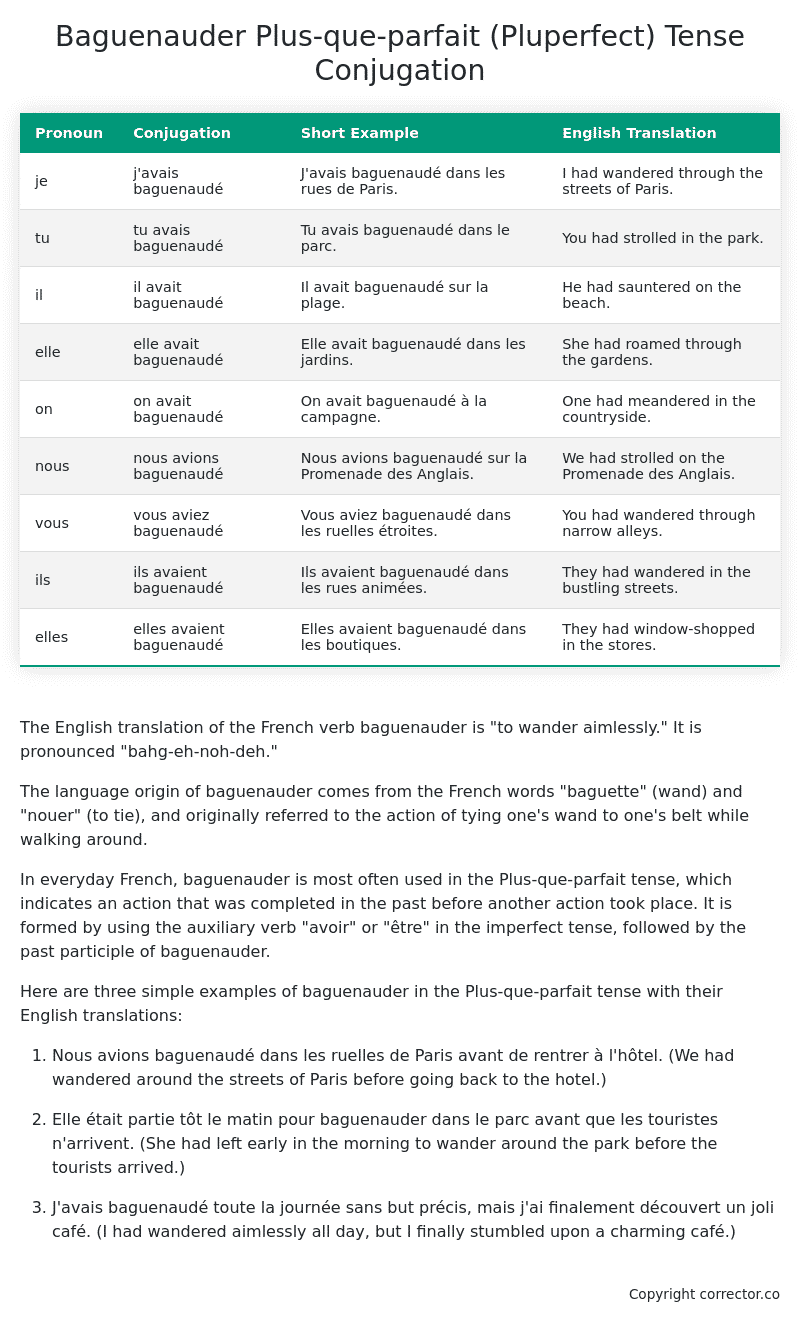Plus-que-parfait (Pluperfect) Tense Conjugation of the French Verb baguenauder
Introduction to the verb baguenauder
The English translation of the French verb baguenauder is “to wander aimlessly.” It is pronounced “bahg-eh-noh-deh.”
The language origin of baguenauder comes from the French words “baguette” (wand) and “nouer” (to tie), and originally referred to the action of tying one’s wand to one’s belt while walking around.
In everyday French, baguenauder is most often used in the Plus-que-parfait tense, which indicates an action that was completed in the past before another action took place. It is formed by using the auxiliary verb “avoir” or “être” in the imperfect tense, followed by the past participle of baguenauder.
Here are three simple examples of baguenauder in the Plus-que-parfait tense with their English translations:
-
Nous avions baguenaudé dans les ruelles de Paris avant de rentrer à l’hôtel. (We had wandered around the streets of Paris before going back to the hotel.)
-
Elle était partie tôt le matin pour baguenauder dans le parc avant que les touristes n’arrivent. (She had left early in the morning to wander around the park before the tourists arrived.)
-
J’avais baguenaudé toute la journée sans but précis, mais j’ai finalement découvert un joli café. (I had wandered aimlessly all day, but I finally stumbled upon a charming café.)
Table of the Plus-que-parfait (Pluperfect) Tense Conjugation of baguenauder
| Pronoun | Conjugation | Short Example | English Translation |
|---|---|---|---|
| je | j’avais baguenaudé | J’avais baguenaudé dans les rues de Paris. | I had wandered through the streets of Paris. |
| tu | tu avais baguenaudé | Tu avais baguenaudé dans le parc. | You had strolled in the park. |
| il | il avait baguenaudé | Il avait baguenaudé sur la plage. | He had sauntered on the beach. |
| elle | elle avait baguenaudé | Elle avait baguenaudé dans les jardins. | She had roamed through the gardens. |
| on | on avait baguenaudé | On avait baguenaudé à la campagne. | One had meandered in the countryside. |
| nous | nous avions baguenaudé | Nous avions baguenaudé sur la Promenade des Anglais. | We had strolled on the Promenade des Anglais. |
| vous | vous aviez baguenaudé | Vous aviez baguenaudé dans les ruelles étroites. | You had wandered through narrow alleys. |
| ils | ils avaient baguenaudé | Ils avaient baguenaudé dans les rues animées. | They had wandered in the bustling streets. |
| elles | elles avaient baguenaudé | Elles avaient baguenaudé dans les boutiques. | They had window-shopped in the stores. |
Other Conjugations for Baguenauder.
Le Present (Present Tense) Conjugation of the French Verb baguenauder
Imparfait (Imperfect) Tense Conjugation of the French Verb baguenauder
Passé Simple (Simple Past) Tense Conjugation of the French Verb baguenauder
Passé Composé (Present Perfect) Tense Conjugation of the French Verb baguenauder
Futur Simple (Simple Future) Tense Conjugation of the French Verb baguenauder
Futur Proche (Near Future) Tense Conjugation of the French Verb baguenauder
Plus-que-parfait (Pluperfect) Tense Conjugation of the French Verb baguenauder (this article)
Passé Antérieur (Past Anterior) Tense Conjugation of the French Verb baguenauder
Futur Antérieur (Future Anterior) Tense Conjugation of the French Verb baguenauder
Subjonctif Présent (Subjunctive Present) Tense Conjugation of the French Verb baguenauder
Subjonctif Passé (Subjunctive Past) Tense Conjugation of the French Verb baguenauder
Subjonctif Imparfait (Subjunctive Imperfect) Tense Conjugation of the French Verb baguenauder
Conditionnel Présent (Conditional Present) Tense Conjugation of the French Verb baguenauder
Conditionnel Passé (Conditional Past) Tense Conjugation of the French Verb baguenauder
L’impératif Présent (Imperative Present) Tense Conjugation of the French Verb baguenauder
L’infinitif Présent (Infinitive Present) Tense Conjugation of the French Verb baguenauder
Struggling with French verbs or the language in general? Why not use our free French Grammar Checker – no registration required!
Get a FREE Download Study Sheet of this Conjugation 🔥
Simply right click the image below, click “save image” and get your free reference for the baguenauder Plus-que-parfait tense conjugation!

Baguenauder – About the French Plus-que-parfait (Pluperfect) Tense
Tense Formation
Common everyday usage patterns
Sequencing of past events
Background information
Hypothetical or reported speech
Interactions with other tenses
Summary
I hope you enjoyed this article on the verb baguenauder. Still in a learning mood? Check out another TOTALLY random French verb conjugation!


